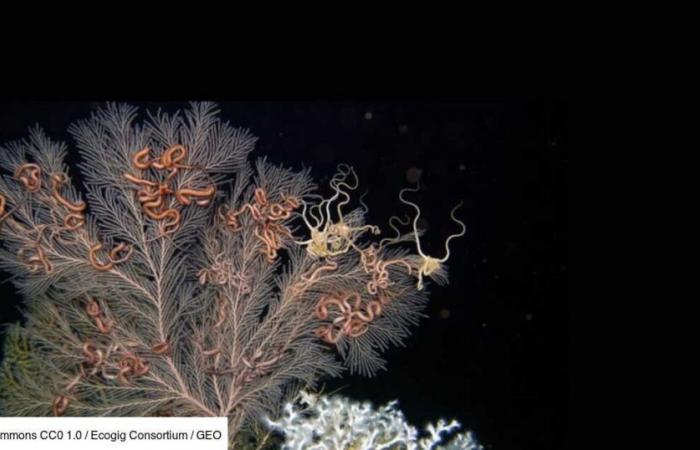The long tortuous arms of the brittle stars, these cousins of the starfish, get tangled in the fine lace of their colony, forming a strange chimera… But true cohabitation escapes our eye. Delta callogorgia et American callogorgia are two species of soft corals from the Gulf of Mexico, inhabiting depths ranging from 300 to 900 meters – where there is total darkness.
By studying some of these coral colonies, a German-American research team discovered two previously unknown species of bacteria closely related to each other. Based on genetic analyses, these microbes could be linked to a whole new family, called Oceanoplasmataceae (press release from the University of Oldenburg).
While tropical corals bathed in light from surface waters benefit from the energy provided by tiny photosynthetic algae (zooxanthellae) carrying out photosynthesis, cold water corals or “deep corals” generally depend on bacteria. to convert nutrients or obtain energy from chemical compounds (chemosynthesis).
A few hundred protein-coding genes
Although the authors of the study published on November 4 in the journal Nature Communications do not yet know whether the bacteria Oceanoplasmataceae provide any benefit to the coral, however, the opposite seems to be true, since the only source of energy for these microbes is arginine, an amino acid provided by their host.
In-depth research revealed that these bacteria lived in symbiosis with these corals, within a gelatinous layer of tissue involved in both immune defense and nutrient transport.
Even more surprising, the newly identified species (Oceanoplasma callogorgiae et Thalassoplasma callogorgiae) contain respectively only 359 and 385 genes coding for proteins ensuring various metabolic functions – for comparison, the intestinal bacteria Escherichia coli contains more than 4,000 of these genes, while humans have around 21,000.
“These bacteria do not even have genes for normal carbohydrate metabolism, that is, for obtaining energy from carbohydrates, which is the case for virtually all living organisms”notes Iliana Baums, professor at the Helmholtz Institute for Functional Marine Biodiversity (HIFMB) at the University of Oldenburg (press release).
Eliminate foreign DNA
And that’s not all. Both bacterial species use “CRISPR/Cas” type systems to eliminate foreign DNA. If this barbaric acronym rings a bell, it’s because it refers to a gene modification technique used in laboratories.
In the case of the ecosystem studied, the authors speculate that these bacterial mechanisms could prove useful to corals, perhaps helping them repel pathogens. A hypothesis which will therefore be the subject of future research work – and probably future discoveries.
Recently, researchers detected the presence of plastic particles in samples of tropical corals, revealing a new clue to determine where plastic ends up and disappears in the ocean. It remains to be seen whether deep corals are also polluted…






